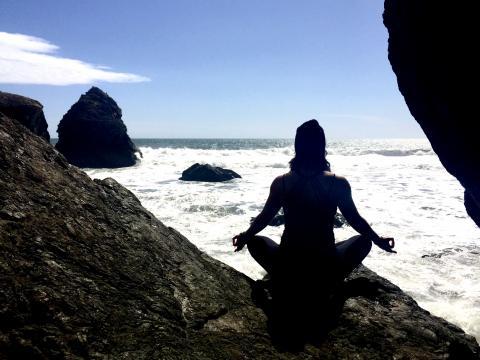
Breathing. You might say it’s important.
Sure, we know it is life juice – a necessity to think, do, speak, say, move about our ways. But what is the real deal behind breathing? Why do yogis and mindfulness practitioners believe in the power of the breath?
In truth, rarely do we notice the quality of our own breath. Often it is an automatic function that resides in the subconscious. Now, think of any moment you have felt frightened, scared, shocked or stressed. Did you notice how your emotions affect your breathing patterns? Different experiences and feelings can stimulate rapid or shallow breathing – two actions that do a disservice to your overall wellbeing.
So let’s understand why breathing is so important and how we can harness its power.
“A yogi measures the span of life by the number of breaths, not by the number of years” – Swami Sivananda.
Breathing influences our lifespan. Humans take some 16 breaths a minute. Look at animals with slower breath rates like elephants compared to those with fast-paced breath rates like rabbits. Who lives longer?
Breathing feeds our livelihood. Biologically, the breath bears oxygen and ensures optimal functioning of our bodies’ processes. It influences every cell in our being and is linked to brain performance. It also serves as our own detoxification ritual, exhaling CO2 and other waste from the body. In fact 80% of the toxins in our body are released through exhales.
Conscious breathing conquers stress. Focusing on deep breathing sends messages to the brain to calm the mind. It triggers the parasympathetic nervous system to engage and counteract sympathetic nervous system (the part responsible for the fight or flight reactions often provoked by daily stress). Bringing awareness to your breath will help shoo that stress. And since stress is a gateway to many other illnesses, you might want to indulge in your inhales.
Conscious breathing helps manage anxiety and lowers heart rate. Since the parasympathetic nervous system is called into action, the vagus nerve is stimulated. This nerve plays a major role in lowering heart rate, reducing blood pressure and combatting depression. Lots of biological wins here.
Conscious breathing can increase focus. A Harvard study shows that controlled breathing often used in meditation can in fact increase brain size and nurture parts of the brain associated with focused attention and processing of sensory information.
The breath brings us into the present moment. Our mind moves a million miles a minute. It lurks in the past and prophesizes about the future. Connecting with the breath is a therapeutic tool used in many mindfulness practices to summon presence.
“Breathing in, I calm body and mind. Breathing out, I smile. Dwelling in the present moment I know this is the only moment.” – Thich Nhat Hanh
The breath unifies body and mind. From an energetic perspective, consider the breath as a bridge between the layers of consciousness. In Yoga we seek to “yuj” or “yoke” the body, mind and spirit and it is through breath that we find balance and union.
In yoga we learn to control the breath through a practice called Pranayama. In Sanskrit, one of the many meanings of “Prana” is “vital energy or life force” and “ayama” means the “extension or expansion.” It is important not to confuse breath with Prana. Prana is a universal force found in all things and our breath contains Prana.
Pranic breathing releases emotional blockages. Our physical bodies hold past experiences – be it memories or even karmic impressions. Take a moment to conjure up a situation that evoked a deep feeling. Close your eyes and notice where that emotion emerges on the body. We may have heartache that results in heaviness in the chest or “a heavy heart.” We may feel stress and burden for others, so mush so that we “carry the weight of the world.” Even our everyday language intimates at this connection between emotions and the body. When parts of the body are in pain, there is a physical layer and subtle energetic layers. Pranic breathing addresses the many layers of consciousness to help release the blockage on a deeper level.
Breathing and Pranayama prepares us for deeper experiences of meditation. In the Hatha yoga tradition, specific pranayama practices are performed after an asana sequence to prepare one for meditation. Through pranayama breath work, one can activate and expand prana past limitation, increasing vibrational energy and awareness. According to the Upanishads, the sound of the breath on inhalation is “So” and on exhalation is “Ham.” In Vedic philosophy so ham is a mantra, “I am that,” thus identifying oneself with the entire universe.
Pranic breathing can unlock various states of consciousness. According to the Ancient Indian science of Yoga, the human body contains over 72,000 nadi or channels. Of these nadi there are three major channels that run up the spine – the ida, pingala and sushumna. It is on the sushumna, central energy nadi, that you will find the 7 major chakras or energy wheels. Each chakra correlates to a layer consciousness. It is the subtle energy of kundalini that awakens at the base of the spine and rises throughout the chakras until it reaches the crown chakra, provoking a state of oneness.
Believe it or not, this only scrapes the surface of breathing. But now you’ve got a brief lowdown and can pocket this knowledge for use. Next time you feel stressed, if your mind wanders off or your thoughts travel hyper-speed… find your breath. Take deep, juicy breaths of life and notice the subtle changes of your wellbeing.








